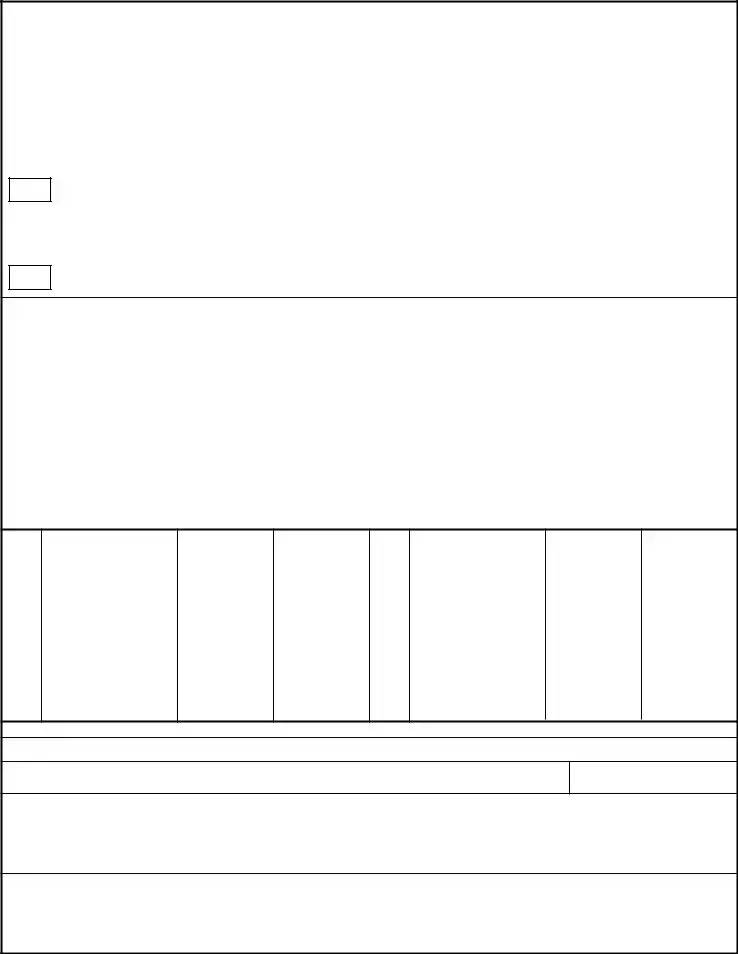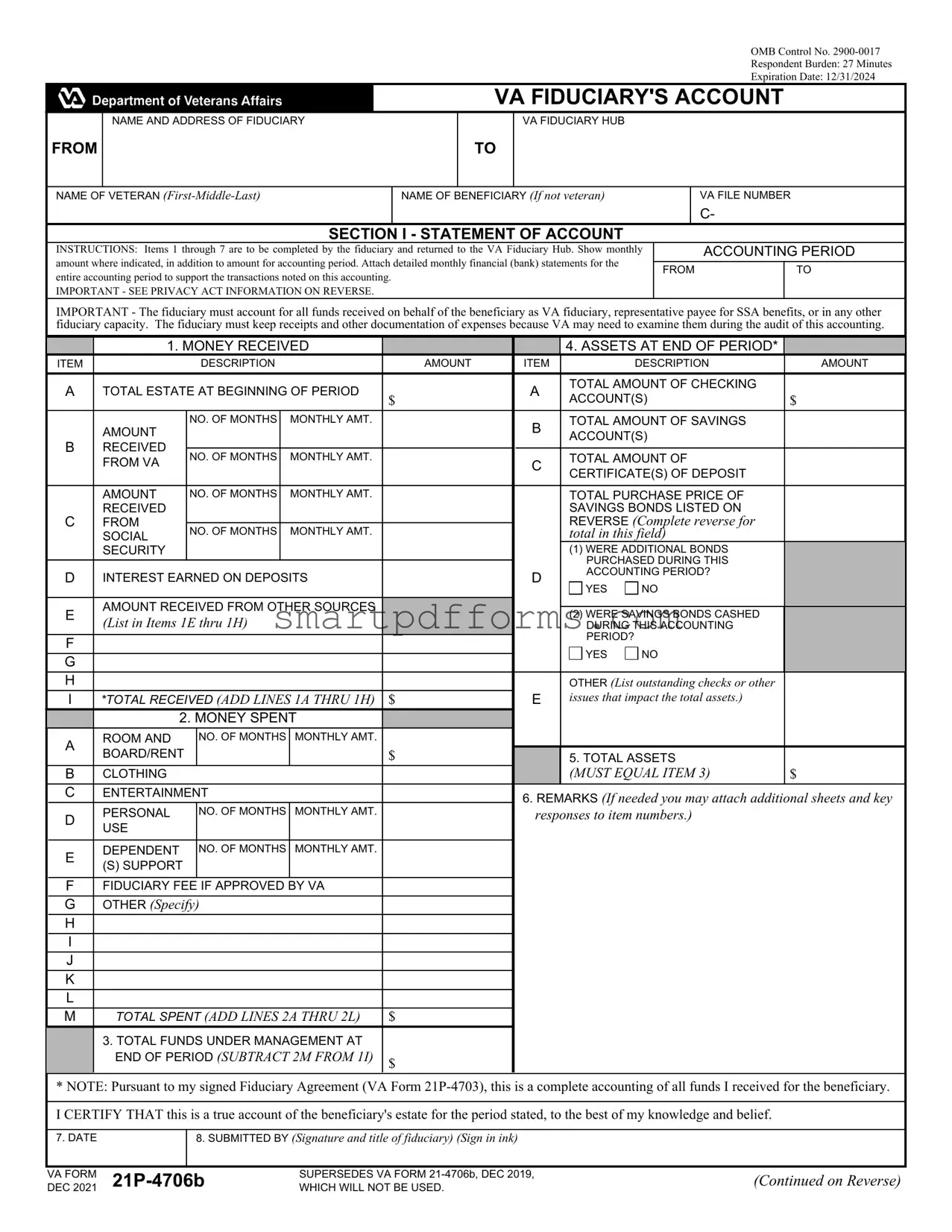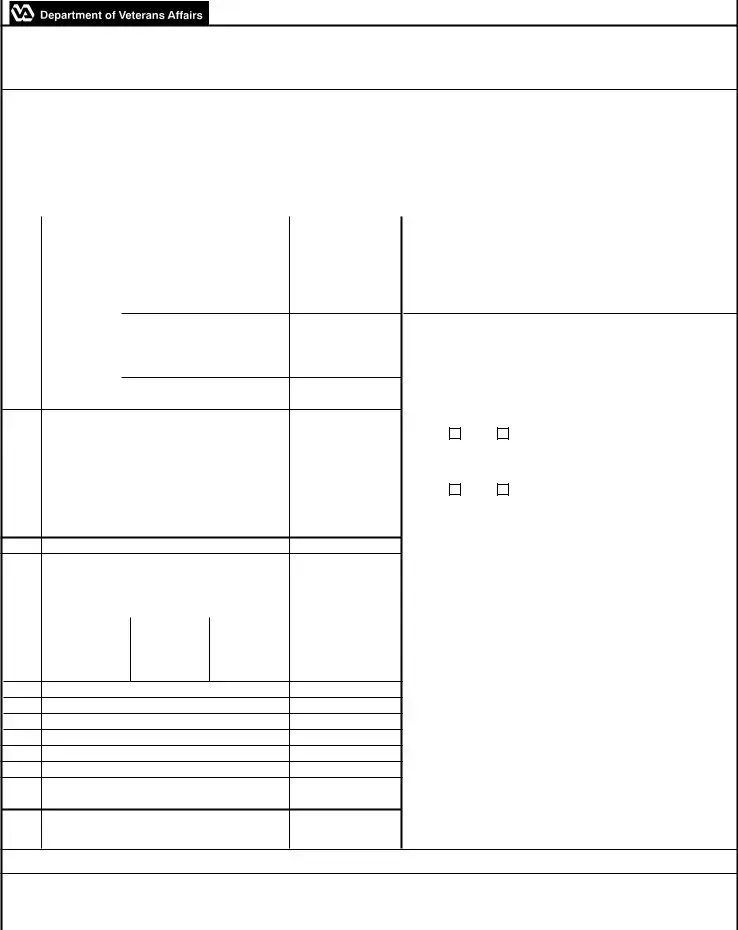|
|
|
|
|
|
|
|
OMB Control No. 2900-0017 |
|
|
|
|
|
|
|
|
Respondent Burden: 27 Minutes |
|
|
|
|
|
|
|
|
Expiration Date: 12/31/2024 |
|
|
|
|
VA FIDUCIARY'S ACCOUNT |
|
NAME AND ADDRESS OF FIDUCIARY |
|
|
|
VA FIDUCIARY HUB |
|
|
|
|
|
FROM |
|
|
TO |
|
|
|
|
|
|
|
|
|
|
|
|
|
|
|
|
NAME OF VETERAN (First-Middle-Last) |
NAME OF BENEFICIARY (If not veteran) |
|
|
VA FILE NUMBER |
|
|
|
|
|
|
|
|
C- |
|
SECTION I - STATEMENT OF ACCOUNT |
|
|
|
|
|
INSTRUCTIONS: Items 1 through 7 are to be completed by the fiduciary and returned to the VA Fiduciary Hub. Show monthly |
|
|
ACCOUNTING PERIOD |
|
amount where indicated, in addition to amount for accounting period. Attach detailed monthly financial (bank) statements for the |
|
|
|
|
|
FROM |
|
TO |
entire accounting period to support the transactions noted on this accounting. |
|
|
|
|
|
|
|
|
|
|
|
|
IMPORTANT - SEE PRIVACY ACT INFORMATION ON REVERSE. |
|
|
|
|
|
|
|
|
IMPORTANT - The fiduciary must account for all funds received on behalf of the beneficiary as VA fiduciary, representative payee for SSA benefits, or in any other fiduciary capacity. The fiduciary must keep receipts and other documentation of expenses because VA may need to examine them during the audit of this accounting.
|
|
1. MONEY RECEIVED |
|
|
|
4. ASSETS AT END OF PERIOD* |
|
|
ITEM |
|
|
DESCRIPTION |
|
|
AMOUNT |
ITEM |
|
DESCRIPTION |
AMOUNT |
|
A |
TOTAL ESTATE AT BEGINNING OF PERIOD |
|
A |
TOTAL AMOUNT OF CHECKING |
|
|
$ |
ACCOUNT(S) |
$ |
|
|
|
|
|
|
|
|
|
|
|
AMOUNT |
NO. OF MONTHS |
|
MONTHLY AMT. |
|
B |
TOTAL AMOUNT OF SAVINGS |
|
|
B |
|
|
|
|
|
|
ACCOUNT(S) |
|
|
|
|
|
|
|
|
|
|
|
RECEIVED |
NO. OF MONTHS |
|
MONTHLY AMT. |
|
|
TOTAL AMOUNT OF |
|
|
|
FROM VA |
|
|
C |
|
|
|
|
|
|
|
|
|
CERTIFICATE(S) OF DEPOSIT |
|
|
|
|
|
|
|
|
|
|
|
|
|
|
|
|
|
|
|
|
|
|
|
|
|
AMOUNT |
NO. OF MONTHS |
|
MONTHLY AMT. |
|
|
TOTAL PURCHASE PRICE OF |
|
|
C |
RECEIVED |
|
|
|
|
|
|
|
SAVINGS BONDS LISTED ON |
|
|
FROM |
|
|
|
|
|
|
|
REVERSE (Complete reverse for |
|
|
|
SOCIAL |
NO. OF MONTHS |
|
MONTHLY AMT. |
|
|
total in this field) |
|
|
|
SECURITY |
|
|
|
|
|
|
|
(1) WERE ADDITIONAL BONDS |
|
|
|
|
|
|
|
|
|
|
|
PURCHASED DURING THIS |
|
|
|
|
|
|
|
|
|
|
|
|
|
D |
INTEREST EARNED ON DEPOSITS |
|
D |
ACCOUNTING PERIOD? |
|
|
|
YES |
NO |
|
|
|
|
|
|
|
|
|
|
|
|
|
E |
AMOUNT RECEIVED FROM OTHER SOURCES |
|
|
|
|
|
|
|
|
(2) WERE SAVINGS BONDS CASHED |
|
|
(List in Items 1E thru 1H) |
|
|
|
|
|
|
|
|
|
|
|
DURING THIS ACCOUNTING |
|
|
F |
|
|
|
|
|
|
|
|
PERIOD? |
|
|
|
|
|
|
|
|
|
|
|
YES |
NO |
|
|
G |
|
|
|
|
|
|
|
|
|
|
|
|
|
|
|
|
|
|
|
|
|
|
H |
|
|
|
|
|
|
|
|
OTHER (List outstanding checks or other |
|
|
I |
*TOTAL RECEIVED (ADD LINES 1A THRU 1H) |
$ |
E |
issues that impact the total assets.) |
|
|
|
2. MONEY SPENT |
|
|
|
|
|
|
|
A |
ROOM AND |
|
NO. OF MONTHS |
MONTHLY AMT. |
|
|
|
|
|
|
|
BOARD/RENT |
|
|
|
|
|
$ |
|
5. TOTAL ASSETS |
|
|
|
|
|
|
|
|
|
|
|
B |
CLOTHING |
|
|
|
|
|
|
|
(MUST EQUAL ITEM 3) |
$ |
|
C |
ENTERTAINMENT |
|
|
|
6. REMARKS (If needed you may attach additional sheets and key |
|
D |
PERSONAL |
|
NO. OF MONTHS |
MONTHLY AMT. |
|
responses to item numbers.) |
|
|
USE |
|
|
|
|
|
|
|
|
|
|
|
|
|
|
|
|
|
|
|
|
|
|
|
E |
DEPENDENT |
|
NO. OF MONTHS |
MONTHLY AMT. |
|
|
|
|
|
|
(S) SUPPORT |
|
|
|
|
|
|
|
|
|
|
|
|
|
|
|
|
|
|
|
|
|
|
FFIDUCIARY FEE IF APPROVED BY VA
G OTHER (Specify)
H
I
J
K
L
M |
TOTAL SPENT (ADD LINES 2A THRU 2L) |
$ |
|
3. TOTAL FUNDS UNDER MANAGEMENT AT |
|
|
END OF PERIOD (SUBTRACT 2M FROM 1I) |
$ |
* NOTE: Pursuant to my signed Fiduciary Agreement (VA Form 21P-4703), this is a complete accounting of all funds I received for the beneficiary.
I CERTIFY THAT this is a true account of the beneficiary's estate for the period stated, to the best of my knowledge and belief.
7. DATE |
|
8. SUBMITTED BY (Signature and title of fiduciary) (Sign in ink) |
|
|
|
|
|
|
VA FORM |
21P-4706b |
SUPERSEDES VA FORM 21-4706b, DEC 2019, |
(Continued on Reverse) |
DEC 2021 |
WHICH WILL NOT BE USED. |

9. BACKGROUND INFORMATION
Answer the questions below if you are an individual appointed to serve as fiduciary for the beneficiary named on the reverse side of this form. The questions pertain to your personal criminal and credit history. Failure to provide a response may impact your ability to serve as a VA fiduciary.
You are not required to respond to these questions if you are serving as VA fiduciary in one of the following capacities for the beneficiary named on the reverse:
•administrator of a facility
•company or corporation
•court-appointed fiduciary who is also appointed by VA
I certify that during this accounting period, I have not been convicted of any offense under Federal or State law, which resulted in imprisonment for more than one year. I understand the Department of Veterans Affairs may obtain my criminal background history to verify my response. Initial the box below to certify and acknowledge this information.
I certify that during this accounting period, I did not default on a debt, was not the subject of collection action by a creditor and did not file bankruptcy. To the best of my knowledge, no adverse credit information was reported to a credit bureau because I was unable to meet my personal financial obligations. I understand the Department of Veterans Affairs may obtain my credit history report to verify my response. Initial the box below to certify and acknowledge this information.
10. EXPLANATION OF BACKGROUND INFORMATION (If necessary)
|
LINE |
SERIAL NUMBER |
DATE OF |
PURCHASE |
LINE |
SERIAL NUMBER |
DATE OF |
PURCHASE |
|
NO. |
PURCHASE |
PRICE |
NO. |
PURCHASE |
PRICE |
|
|
|
|
|
|
|
|
|
|
|
|
|
1. |
|
|
|
6. |
|
|
|
|
|
|
|
|
|
|
|
|
|
2. |
|
|
|
7. |
|
|
|
|
|
|
|
|
|
|
|
|
|
3. |
|
|
|
8. |
|
|
|
|
|
|
|
|
|
|
|
|
|
4. |
|
|
|
9. |
|
|
|
|
|
|
|
|
|
|
|
|
|
5. |
|
|
|
10. |
|
|
|
SECTION II - CERTIFICATION OF U.S. SAVINGS BONDS
I CERTIFY THAT the savings bonds listed above are the property of the estate of the beneficiary and are in my custody and control.
SIGNATURE OF FIDUCIARY (Sign in ink)
PRIVACY ACT INFORMATION: The VA will not disclose information on the form to any source other than what has been authorized under the Privacy Act of 1974 or Title 5, Code of Federal Regulations 1.526 for routine uses (i.e. request from Congressman on behalf of a beneficiary) as identified in the VA system of records, 37VA27, VA Supervised Fiduciary/Beneficiary and General Investigative Records, published in the Federal Register. You are required to respond (38 U.S.C. 5701) to obtain or retain benefits. The information will be used to ensure the proper administration of the beneficiary's income and estate. Failure to furnish the requested information may result in the suspension of payments and/or the appointment of a successor fiduciary.
RESPONDENT BURDEN: We need this information to ensure proper administration of the beneficiary's estate. Title 38, United States Code allows us to ask for this information. We estimate that you will need an average of 27 minutes to review the instructions, find the information, and complete this form. VA cannot conduct or sponsor a collection of information unless a valid OMB control number is displayed. You are not required to respond to a collection of information if this number is not displayed. Valid OMB control numbers can be located on the OMB Internet Page at https://reginfo.gov/public/do/PRAMain.
VA FORM 21P-4706b, DEC 2021


